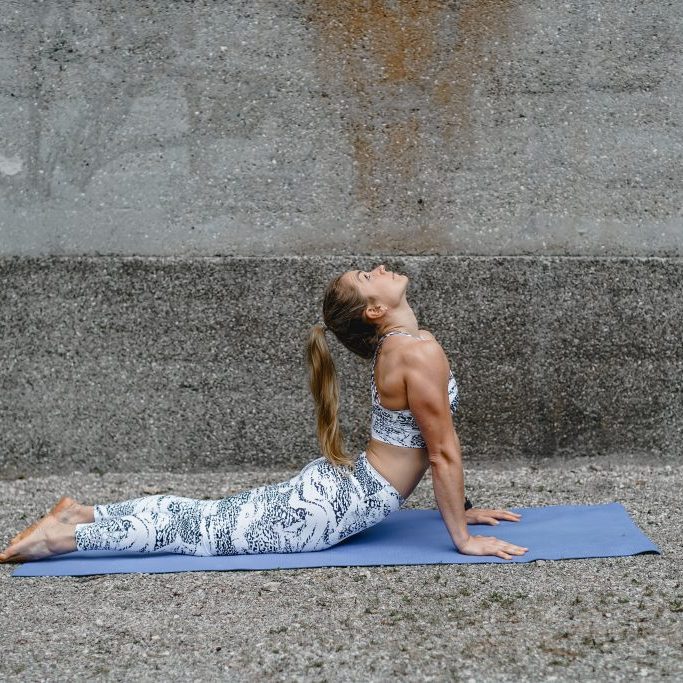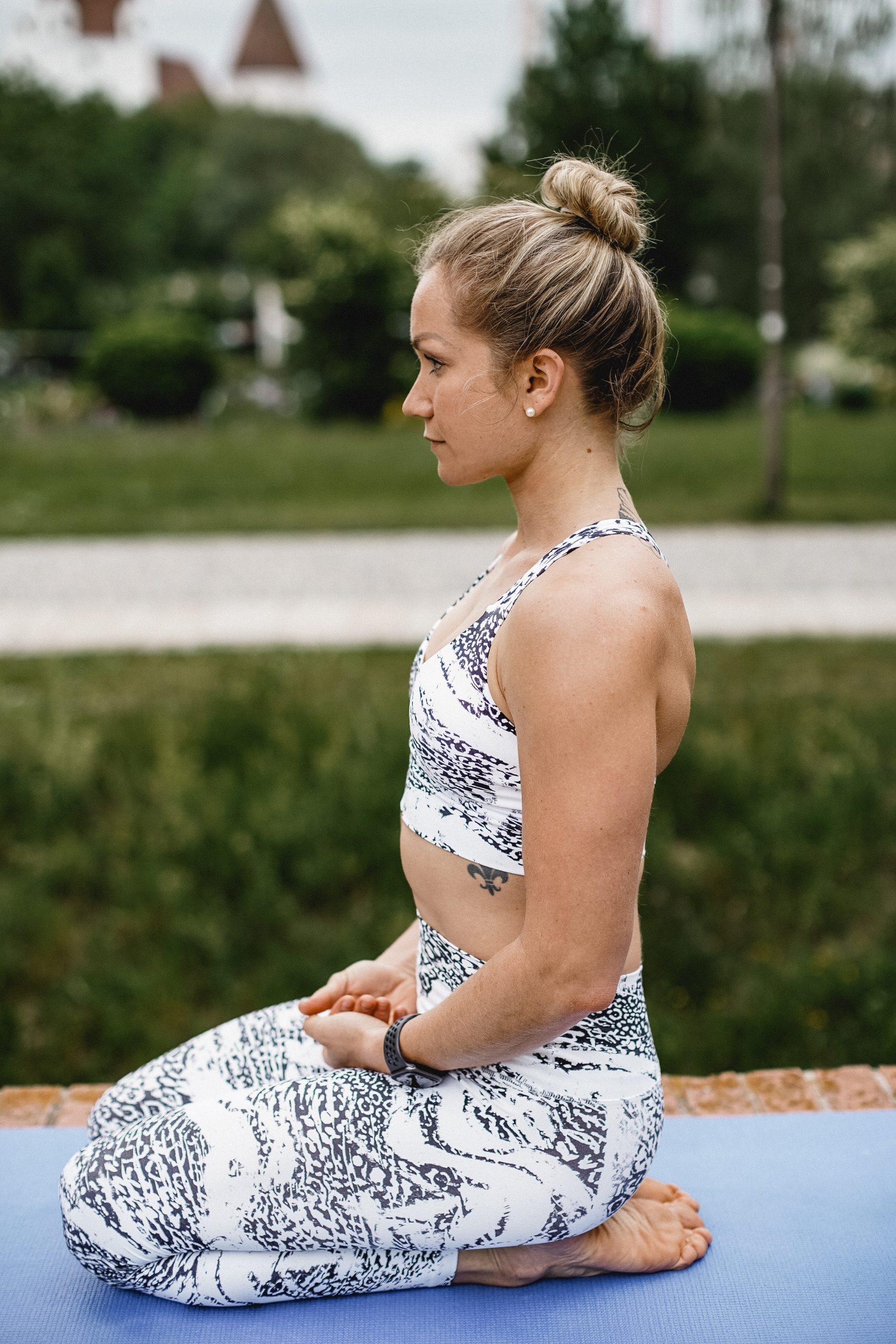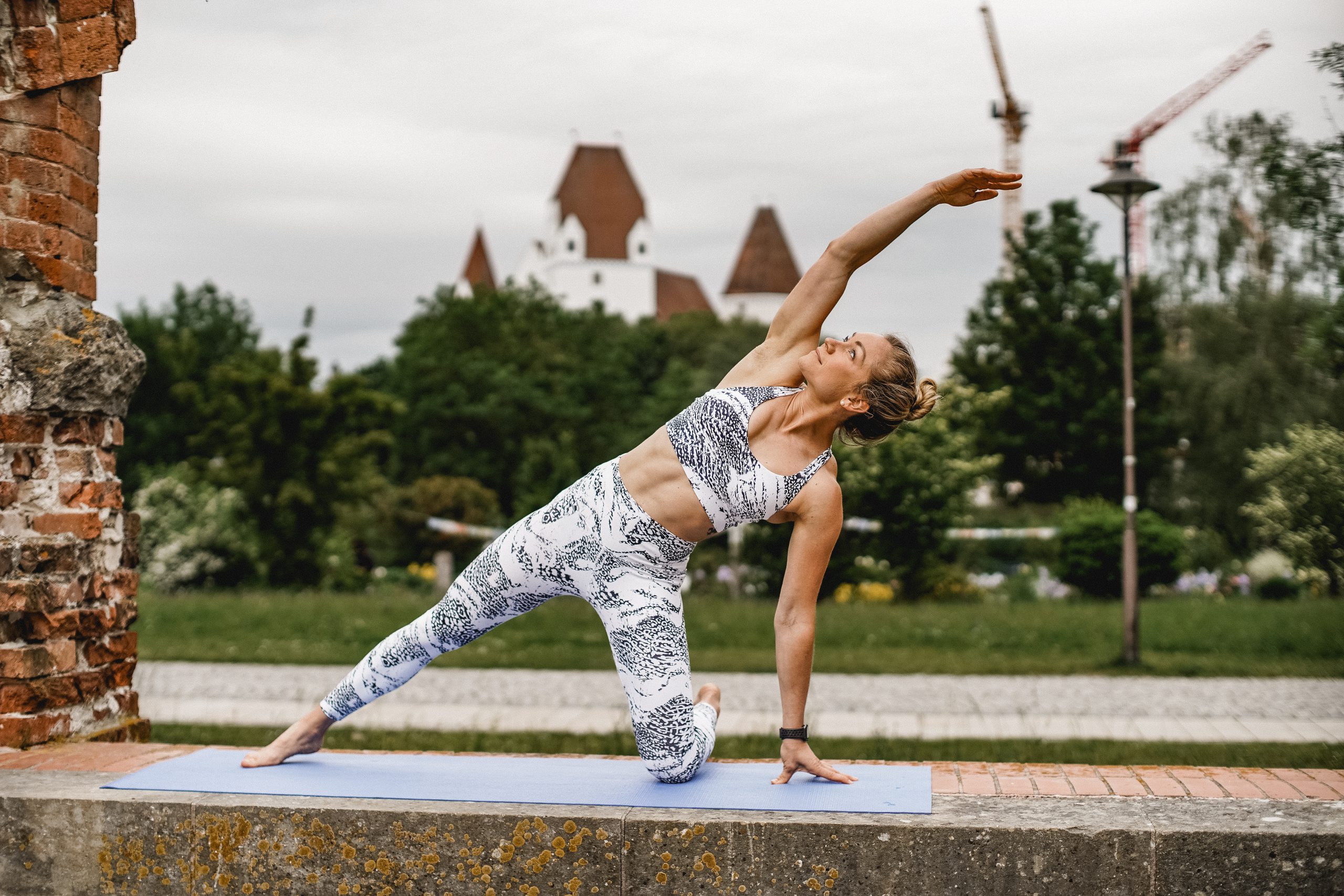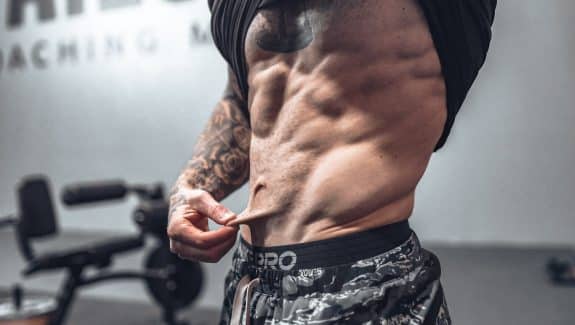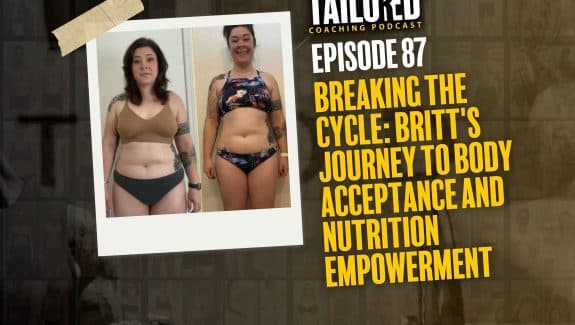Many guys (and even gals) who are into strength training switch off when they hear the four letter word – YOGA
They tend to associate super skinny, hypermobile people, chanting and a bunch of tree-hugging vegans with it.
But little do they know
- that there are many different styles of Yoga and you can really make it fit your personality, time availability and goals
- about the multitude of physical and mental benefits they and their training are missing out on!
I might be a female (definitely not vegan and definitely not tree hugging :), but I am a strength training enthusiast just like you and in this blog I want to:
→ Tell you about the benefits Yoga has on at least 4 of the 10 Components of Fitness
→ Why this is going to serve as a form of injury prevention and a performance boost
→ Describe some of the recovery benefits and how Yoga can help you learn to breathe better during your lifts as well
→ Explain how it can also teach you mental perseverance
→ Show you that your excuses are invalid
→ Go into what kind of Yoga is NOT beneficial before your training and what kind of Yoga is NOT beneficial after your training and why
→ Lay out two easy 5 Minute Yoga sequences
Going forward I will mostly be referring to Yoga in the sense of fluid Yoga practices like Power Yoga, Hatha Yoga, Ashtanga Yoga etc and less in the sense of more spiritual based Yoga practices like Kundalini Yoga. I will touch on Yin Yoga in the section of mental perseverance and recovery.
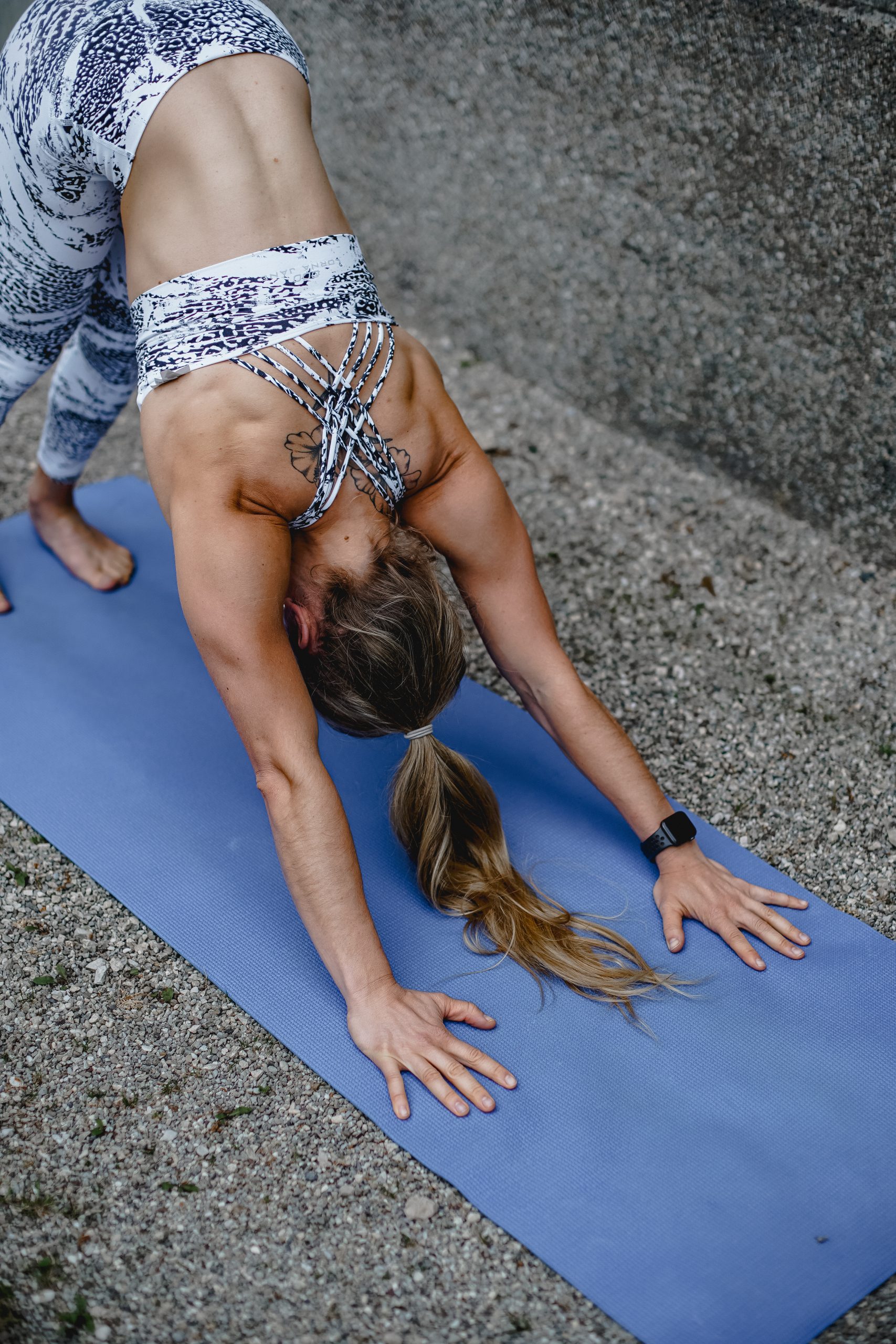
How Yoga benefits your overall Fitness
The 10 Components of Fitness are:
→ Cardiovascular Endurance: The ability of body systems to gather, process, and deliver oxygen.
→ Stamina: The ability of body’s systems to process, deliver, store, and utilize energy. (so in other words ‘muscular endurance)
→ Strength: The ability of a muscular unit, or combination of muscular units, to apply force.
→ Flexibility: the ability to maximize the range of motion at a given joint.
→ Power: The ability of a muscular unit, or combination of muscular units, to apply maximum force in minimum time (this means explosive strength).
→Speed: The ability to minimize the time cycle of a repeated movement. (not necessarily strength related)
→ Agility: The ability to minimize transition time from one movement pattern to another.
→ Coordination: The ability to combine several distinct movement patterns into a singular distinct movement.
→ Balance: The ability to control the placement of the body’s center of gravity in relation to its support base.
→ Accuracy: The ability to control movement in a given direction or at a given intensity.
I think you would probably agree straight away that Yoga helps your FLEXIBILITY, so enabling you to maximize range of motion at a given joint.
Just reading this definition of flexibility shows you that Yoga can help improve your squat position, overhead position, posterior chain length…
Of course the important part is to always access your flexibility in a controlled manner with sufficient strength to move through the movement safely rather than forcing yourself in a position or rather than becoming hyper flexible.
If you have ever practiced or just watched someone do Yoga, you’d likely also agree, that it would help improve BALANCE, so the ability to control the placement of your body’s center of gravity in relation to its support base. Don’t you think that this could also have a positive effect on the balance that you need for any Olympic Lifts, particularly the Snatch? Or maybe for your handstand walk in your next CrossFit Competition, but also for a ‘simple’ Bench Press when you are balancing the Barbell?
Even if to a lesser degree, many Yoga poses certainly also have a positive effect on your Stamina, so your muscular endurance, as well as on your strength, so the ability to apply force. Proper yoga classes also incorporate lot’s of planks, core work, lots of lunge holds, head-/handstands, one legged stances…
Lastly, Yoga also improves coordination. “What arm am I putting with which foot? And how do I twist that leg over to this side??” It might not have a direct transfer to your sport, but you can probably imagine that generally improving your coordination forms certain patterns in your brain that help your overall coordination – in everyday life as well as your training.
Essentially that means no matter your sport – Gymnastics, CrossFit, BodyBuilding, Powerlifting, Olympic Lifting, StrongMan, Obstacle Racing, Running… Yoga is going to help you perform better in your sport in at least a couple of aspects.
The effects on injury prevention and performance
You can probably imagine that having full range of motion (ROM) across your joints can help you grow old in a healthier more independent way (getting up when you fall down, reaching for something on a high shelf…), but you may not realize that going into full ROM also helps prevent injuries now. Training without placing any attention on mobility work leads to tight muscles, smaller range of motion and a compromised power output. We have all seen that person who is so buff, they can’t even scratch his/her own back or bend down to tie their shoes properly. In the long run this is likely to lead to muscular imbalances, and therefore often eventually some sort of structural issues due to overuse in one area and neglect in the other which leads to injuries like slipped discs, failed lifts because of incorrect posture due to limited ROM…
Naturally, if you have full range of motion across your joints you can train your muscles across such. That will not just inevitably lead to better form, but also increased strength. If your ROM is only increasing slowly, but you don’t want to back off from the heavy weights you normally use, I recommend designating one training session per week solely focusing on form and backing off on weight and one training session with a smaller, but controlled ROM like with Box Squats, Floor Press, partial Deadlifts etc.
Remember that it is mostly your ego holding you back from reducing the weights used. You won’t lose a ton of strength by focusing on form more for a little while, on the contrary.
Particularly since Yoga is not just focused on increasing ROM, but on doing so with control and simultaneously building up strength within the deep stabilizing musculature to make sure we do so safely, Yoga will also help your performance in that way. Many people want to deadlift 2-3 times their body weight, but can’t even hold a plank or hollow body for a couple of minutes, yet alone control their body enough to do one legged standing poses like Warrior 3.
We are often afraid to go back to basics when we have been training for a few years. But the truth is that nearly all of us can benefit from placing at least some of our focus on accessing our full range of motion and strengthening the deep musculature, especially in our core, along the spine, the rotator cuff and around our hip girdle.
Yoga as a way to improve your Recovery and Breathing
We all know that if we recover faster we can train more or harder and therefore perform better.
We also know that we need to relax to recover. Not just physically, but also mentally. Our Central-Nervous-System (CNS) needs to be able to wind down, cortisol needs to come down, we need to get out of that activated fight or flight state that we are so often in in our modern lives (work stress, emotional stress, undereating or eating crappy food, not sleeping enough, high training volume…).
There are three distinct ways in which Yoga can help you get to a state of relaxation:
→ Switching off your mind from your to-do lists, from rushing from one thing to the next. Simply focusing on being present. Being on your mat (or your gym or living room floor…wherever you are at).
→ Getting your physical body to relax and bringing down the tonus/tension in your muscles. Even if you practise Power Yoga or more active types of Yoga, each class normally has a part that is focused on winding down and relaxation. There is also almost always a part where certain poses are held for at least 20-30s, sometimes as long as three minutes (as opposed to a flow from one pose to the next). This is particularly the case in Yoga styles like Yin Yoga. How often over the course of your day do you normally take the time just to stay in one (beneficial) position for a couple of minutes, allowing your body to slow down?? Likely not all that frequently.
→ And the last aspect of this is your BREATH.
Yoga and breath work are deeply connected. Almost all classes start with a few minutes of breath work. An example for this is Box Breathing (which is even used in the Military), “fire breathing” or Wim Hof breathing exercises. But even if there is no designated part focusing on breathing, Yoga teaches you to breathe into your belly, to lean into uncomfortable situations or positions through deep breathing and is also based on the principle to move WITH your breath!
Yoga and Mental Perseverance
Doing uncomfortable things fosters mental perseverance. Any kind of uncomfortable thing. Whether that is taking a cold shower every morning, doing your meal prep even if you don’t want to, having tough conversations that need to be had… or staying in an uncomfortable Yoga position. If you have ever partaken in a Yin Yoga class where stretches are held for up to 3 minutes, you know what I am talking about. But you really don’t need to take it this far. For most people holding a position for 30s, easing off and then going again for another 30s is absolutely enough. I highly recommend reading David Goggins’ book “Can’t hurt me”, which is not about Yoga at all, but rather about Navy Seals Training, Ultra Running, World Records for 1000 Pull-ups, Powerlifting… but basically about building “mental cullesses ”. The theory is to expose yourself to something you find uncomfortable daily/ regularly and thus building up your mental perseverance.
In addition to that, any kind of introspection, willingness to work on weaknesses or getting to know yourself better during meditation takes will power and self-discipline, which also build mental perseverance. You might regard these sorts of practices as ‘boring, useless and like a waste of time’. And it did to me too, at first.
But meditation is not something that makes you feel awesome straight away. You won’t feel enlightened immediately afterwards. It is a gradual build up that will eventually help you find calmness in the middle of your day. Having inner stillness is not about needing to escape to a super quiet space every time chaos comes up. It means being able to calm the mind in the midst of chaos. But you won’t learn how to do that, how not to freak out if something happens or overreact to a situation, if you don’t practice.
Almost every Yoga class finishes with at least 3-5 minutes of “Savasana”, the corpse pose, so essentially just laying there. The purpose of this is to learn to JUST BE, a colossal challenge for most people. I have been asked so many times “but how do >I think of nothing<?”. But the purpose of meditation is not necessarily to think of ‘nothing’. As mentioned, it is to calm your mind. If thoughts pop up (like ‘what am I going to have for dinner?’ or ‘I need to get out of here to pick up my kids’) acknowledge them and let them drift away, like a cloud in the sky. Focus on your breath if it helps you, take a mental journey through your body and explore how you feel. Use PMR techniques to help you stay focused…
Your excuses are invalid
The most common ‘excuses’ why people don’t do Yoga or any other kind of stretching are:
→ I don’t have time/ It takes too long
You can see massive improvements over time with as little as 5 -10 minutes a day. A little something every day or at least on every training day, is better than nothing and often actually better for performance than 1 whole hour every week. In the end, as always, it comes down to what you can CONSISTENTLY stick with. Start small and stop overwhelming yourself thinking you need to stretch for 30 minutes every single day. Listen to Stephen Covey’s words “Most of us think we don’t have time to take care of our bodies. What a distorted paradigm! We don’t have time not to! Most practises related to physical health take about 1-2 hours per day at the very most. That is about 6 hours a week with one rest day. That hardly seems an inordinate amount of time considering the tremendous benefits in terms of the impact on the other 162 hours of the week.” (also very highly recommended book “The 7 habits of Highly Effective People”)
→ It’s not fun/ boring/ not my style
First of all, get over yourself. Most of us did not enjoy working out at first either, then it became a habit. Most of us don’t particularly enjoy meal prep or picking the chicken and veggies on most days when the majority of the population out there consumes pizza, wine and donuts. Most of us don’t think brushing their teeth is an exhilarating thrill, but we still do it, because we are aware of the immense benefits of it. Every new habit is annoying at first, requires work at first, that mental perseverance. So bite the bullet and start somewhere. Make it a new habit by paring it to another habit (like your training), replace a “bad” habit (like watching too much TV) with it (or you could even do some stretches while watching TV :P) or schedule a particular time slot for it every week.
→ It’s too expensive but I don’t know where to start
The financial part is just plain up an excuse. I am not suggesting you buy a 200$ yoga studio membership. There is SO much free information out there and also some really great reasonably priced classes available. You could start with a free Youtube 10 Minute Morning Yoga session or by trying a full class on DoYogaWithMe. There are also lots of great mobility Apps like ROMWOD where you pay a small subscription fee or maybe your training app contains a mobility program like the “DAILY FLOW” in our Tailored Trainer App.
If you are really completely new to mobility work, but you don’t have the time/don’t want to do your own research on where to start, I would definitely recommend following a structured program whether that is in an App, a class or with a personal trainer. Otherwise you will likely not stay consistent with it. Remember, with any new habit it really pays off not just having the information, but also having some form of accountability (could be through a friend, a coach or a community). You also want to avoid starting in a place that is just way too hard for you and then getting discouraged. So make sure you pick something that suits your level. For example check out THIS 10 minute Yoga sequence for beginners.
→ My flexibility sucks/ I’d rather lift
Again, get over yourself. Everybody has to start somewhere. Many of us were not able to do a push-up when we first started strength training. Most people feel lost and awkward too when they first set foot in a gym. Most things suck when you are bad at them, so no wonder you would rather go lift. But remember your lifting would get better with you improving your ROM too. So why not do both?
You may be thinking “but I have heard stretching before my training is not good for performance and can actually lead to injuries”…
What’s the deal with that?
That brings me to my next point…
→ Not all kinds of Yoga are beneficial BEFORE your training and not all kinds of Yoga are beneficial AFTER your training
You are completely right, STATIC stretches are NOT ideal BEFORE your training. There is a muscular component to that and a neurological one. So for one, we don’t want to lose tension in your muscles before we even start training. The whole point of a warmup is to activate them and to increase range of motion before your training. That is why you should focus on Poses/ Stretches that keep your muscles engaged if you practise Yoga BEFORE your training, so things like lunge variations, Downward/ Upward Facing Dog, Chair Pose to Forward Fold, Side Plank Variations… Also focus on moving with your breath, so something like “exhale – downward dog, inhale – upward dog” and then cycling through that 3-5 times. This would be a great spinal warm up, that also activates your shoulders, increases ROM in hamstrings and calves and your wrists. More activating Yoga styles like Hatha Yoga, Power Yoga or Ashtanga Yoga follow this kind of scheme.
The neurological component is why STATIC stretches are not recommended BEFORE your workout, but can be a great way to help you relax AFTER you workout or on a rest day. When we relax into a static stretch and hold this for a number of minutes our CNS winds down too. Of course you don’t want to switch off your CNS before you train, on the contrary you want to activate it, but the quicker you can activate the parasympathetic nervous system AFTER your workout the faster you will start recovering. That means poses like a Cross Body Stretch, Pigeon Pose, Happy Baby Pose, Seated forward folds… all great ways for you to start relaxing AND simultaneously you may also help take some of that tension out of your muscle. Yin Yoga is the style of Yoga that mostly focuses on longer holds but many other classes incorporate static stretches more towards the end of the practice.
You can definitely incorporate these stretches on a rest day as well, just make sure you really listen to your body in regards to how deep you should go into the stretch.
Whether a more active yoga practice is advisable for your rest day or not depends on how fatigued you are from your training sessions.
A point worth mentioning is BIKRAM/ HOT YOGA. Even though stretches are held for 90s in Bikram Yoga, it is NOT considered a recovery protocol, because the heat itself has a very stressful effect on the body. BIKRAM Yoga counts more as a training session on its own. You may want to consider switching to a style that emphasizes the parathympatic nervous system more to help you recover better and learn to “wind down”.
Two 5 Minute Yoga sequences to incorporate in your daily training regime
A: 5 Minute Yoga Sequence to do BEFORE your training (activating)
First, before jumping into the sequence, sit in HERO POSE and take 10 deep breaths
→ inhaling deeply into your belly for 4 seconds, holding your breath at the top for 4 seconds, exhaling for 4 seconds, holding at the bottom for 4 seconds
→ accept the discomfort of sitting on your heels
This is known as Box Breathing
1. Cat and Cow Flow
- Inhale deeply on Cow pose, push through your shoulder blades
- Exhale deeply into Cat pose, look up
- Repeat for a total of 10 times
- Focus on incorporating all vertebrae, shoulder blades, neck and tailbone
2. Child’s Pose to Cobra
- Exhale deeply into Child’s Pose
- Inhale deeply into Cobra, look up
- Repeat for a total of 10 times
- Focus on lengthening your back, opening and closing your hip fully
3. Downward Facing Dog to Upward Facing Dog
- Exhale deeply into Downward Facing Dog
- Inhale deeply when “diving forward”, moving through a push up into Upward Facing, look up
- Repeat for a total of 10 times
- Focus on lengthening your posterior chain, including hamstrings and ankles as well as starting to activate your shoulders, wrists and core
4. Lunge with Spinal Twist
- Step your right foot forward into a High Lunge Position keeping your rear knee off the ground if possible
- Twist your upper body towards the ceiling and then return to the initial position
- Inhale as you twist, exhale as you return to “start”
- Repeat for a total of 10 times, then repeat on the other side
- Focus on initiating the movement from the lower spine
5. Bottom Squat – Forward Fold – Reach
- Step your other foot forward too, so that you are in your Bottom Squat position
- Raise your hips as you exhale, while folding your torso forward, finishing in a standing forward fold (bend your knees if you need to)
- Inhale raise up and reach up to the sky
- Exhald forward fold again, inhale back down to Bottom Squat
- Repeat for a total of 5 times
- Focus: Hip and ankle mobility, length in spine
Start your workout or go about your day 🙂
B: 5 Minute Yoga Sequence to do AFTER your training (relaxing)
1. Pigeon Pose
- Hold for 30 s each side, every 10 seconds see if you can move deeper into the stretch, focus on your breath
- The front shin would be at 90 degrees to your torso in an IDEAL scenario. The more of a beginner you are the more you may want to bend that knee and bring the foot towards your groin
2. Frog Pose
- Hold for 60 seconds, reset after 30 seconds and then see if you can go deeper the seconds time around
- Focus on your breath, this will be uncomfortable, work on your mental perseverance
3. Happy Baby Pose
- Hold for 60 seconds, focus on your hips and see how you let go of tension over the course of the minute
- Work on your breathing, on going inwards, on “meditating” at the same time
4. Supine Spinal Twist
- Lay down flat on your back
- Bring your right knee to your chest and then guide the knee over to the left side of your body while keeping your right shoulder on the ground
- Look over to your right shoulder
- Let gravity do the work and relax in the position for 30s, then switch sides
5. Child’s pose with wide knees
- Get into tabletop position, open your knees slightly wider than hip width, then sit your hips back as far as possible, ideally with butt touching your heels (feet flat on the floor)
- Reach arms out in front of your let your forehead relax on the ground
- Stay in this position for 1 minute, breathing deeply, getting your torso to melt to the floor, hips to let go of tension and back to lengthen
Hope this was a good way to finish your workout. Go home, enjoy a post-workout meal and go about your day!
I hope after reading about the benefits that Yoga might have on your training and everyday life, you are keen to give it a go!
If you are already a member of the Tailored Trainer and you want to give the “DAILY FLOW” a go, just let us know in the facebook group :)!
Resources:
- Breathing example
- Book recommendation: David Goggins “Can’t Hurt me”
- Relaxation: Progressive Muscle Relaxation
- Book recommendation: Stephen R. Covey “The 7 Habits of Highly Effective People”
- YouTube: 10 Minute Morning Yoga
- DoYogaWithMe
- The Tailored Trainer
- 10 Minute Yoga for beginners
- Hero Pose
- Cat and Cow Flow
- Cobra to Child’s Pose
- Upward/ Downward Dog
- Lunge with Twist
- Squat to Forward Fold
- Forward Fold to Reach
- Pigeon Pose
- Frog Pose
- Happy Baby Pose
- Supine Spinal Twist
- Child’s Pose

